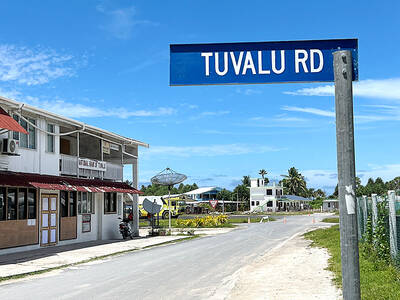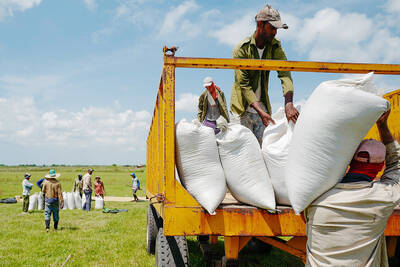As the rain begins to fall on Tanzania’s Tarangire National Park, thousands of zebra, wildebeest and giraffe will begin one of the world’s greatest migrations. But many of the herds trampling across the grass at the foot of the Rift Valley highlands are falling in number — and scientists do not know why.
To find out, they are using a new “photo-fit” system that can recognize individual animals by their unique skin patterns, which are as distinct as a human fingerprint.
The park, dotted with muddy water holes and ancient baobab and acacia trees, has the highest diversity of migratory hoofed mammal (ungulate) species in the world. The animals move out of the park as the wet season begins, in search of new feeding and calving grounds. They will make the return dry season journey in June, to take advantage of the permanent water of the Tarangire River.
Numbers of wildebeest have fallen from 50,000 to 6,000 in the past 20 years, and numbers of antelope species, such as hartebeest and oryx, have declined by 90 percent and 95 percent respectively. Confusingly some species — zebra, giraffe, gazelle and buffalo — have remained relatively stable. To understand such contrasting fortunes, scientists from the Dartmouth and Utah universities in the US are working to determine whether habitat loss, changed food sources, or hunting — or a combination of all — is responsible.
Traditionally animals have been tracked by being captured and tagged, but that is “expensive and invasive,” Dartmouth’s Doug Bolger said.
Scientists have turned to computer-assisted photo identification — the first time the method has been used on such a large scale.
“This new technology allows us to get the best handle on what the population is doing,” Bolger said.
“What we’d like to understand is why some migratory routes have shut down,” he said. “By analyzing the movement of certain species, we hope to understand what makes a landscape they will pass through and what won’t.”
The team identify an individual animal by its stripe width, color and shape, the distance between the marks and whether it has unique characteristics such as scars or, in the case of some wildebeest, broken or deformed horns.
Hundreds of digital images are collected in the field each day and the animal’s stripe or spot pattern is mapped using a 3D model. Custom-built software then extracts the pattern and compares it with a database of previously photographed individuals.
At a later stage the figures will be crunched through another computer program, to generate estimates of population size, survival and reproduction rates.
“We’re still at least a year away from being able to use all this data to come up with population estimates and survival rates,” Bolger said.
But as more and more animals are added to the researchers’ photo albums, the difficulties the herds face on their trek across the picture-perfect savannah come a little closer to being understood — and protection is a step closer.

FORUM: The Solomon Islands’ move to bar Taiwan, the US and others from the Pacific Islands Forum has sparked criticism that Beijing’s influence was behind the decision Tuvaluan Prime Minister Feletei Teo said his country might pull out of the region’s top political meeting next month, after host nation Solomon Islands moved to block all external partners — including China, the US and Taiwan — from attending. The Pacific Islands Forum (PIF) leaders’ meeting is to be held in Honiara in September. On Thursday last week, Solomon Islands Prime Minister Jeremiah Manele told parliament that no dialogue partners would be invited to the annual gathering. Countries outside the Pacific, known as “dialogue partners,” have attended the forum since 1989, to work with Pacific leaders and contribute to discussions around

END OF AN ERA: The vote brings the curtain down on 20 years of socialist rule, which began in 2005 when Evo Morales, an indigenous coca farmer, was elected president A center-right senator and a right-wing former president are to advance to a run-off for Bolivia’s presidency after the first round of elections on Sunday, marking the end of two decades of leftist rule, preliminary official results showed. Bolivian Senator Rodrigo Paz was the surprise front-runner, with 32.15 percent of the vote cast in an election dominated by a deep economic crisis, results published by the electoral commission showed. He was followed by former Bolivian president Jorge “Tuto” Quiroga in second with 26.87 percent, according to results based on 92 percent of votes cast. Millionaire businessman Samuel Doria Medina, who had been tipped

Outside Havana, a combine belonging to a private Vietnamese company is harvesting rice, directly farming Cuban land — in a first — to help address acute food shortages in the country. The Cuban government has granted Agri VAM, a subsidiary of Vietnam’s Fujinuco Group, 1,000 hectares of arable land in Los Palacios, 118km west of the capital. Vietnam has advised Cuba on rice cultivation in the past, but this is the first time a private firm has done the farming itself. The government approved the move after a 52 percent plunge in overall agricultural production between 2018 and 2023, according to data

ELECTION DISTRACTION? When attention shifted away from the fight against the militants to politics, losses and setbacks in the battlefield increased, an analyst said Recent clashes in Somalia’s semi-autonomous Jubaland region are alarming experts, exposing cracks in the country’s federal system and creating an opening for militant group al-Shabaab to gain ground. Following years of conflict, Somalia is a loose federation of five semi-autonomous member states — Puntland, Jubaland, Galmudug, Hirshabelle and South West — that maintain often fractious relations with the central government in the capital, Mogadishu. However, ahead of elections next year, Somalia has sought to assert control over its member states, which security analysts said has created gaps for al-Shabaab infiltration. Last week, two Somalian soldiers were killed in clashes between pro-government forces and